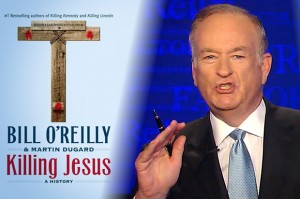Killing Jesus
Killing Jesus: A History by Bill O’Reillly and Martin Dugard (New York: Henry Holt and Co., 2013).
Serious study about the historical background of Jesus of Nazareth as described in the Gospels and New Testament has amassed a formidable library of material for more than a century. The endeavor gave rise to the scholarly expression of the “Quest” of the Historical Jesus. The term aptly portrayed the search for historical information that would offer reliable background for the portrait of Jesus in the religious literature of the Gospels. As “quest” implies, this expedition into the ancient sources from the time of Jesus was optimistically viewed as a voyage of discovery, which would finally give more certitude to our confidence in the words and deeds of Jesus as handed down in the Gospels.
However, it became evident by the early twentieth-century with the relentless critical analysis of German scholars like Rudolf Bultmann that naïve reliance on the Gospel texts themselves as a source of accurate historical information would not bring such positive outcomes as was hoped. Gradually through the twentieth century, it became more evident that the Quest of the Historical Jesus would have to begin not with biblical accounts of Jesus’ infancy, but rather from the end of a process of development, which had only brought the Gospels into existence over many decades, and under the significant influence of factors not directly related to historical facts about Jesus.
In other words, the Gospels could no longer be presumed to be historical sources pure and simple. Rather, the nature of these texts as documents of faith, which were composed gradually within Christian communities, especially in the light of Christian faith in the resurrection of Jesus, definitively cast the literary-theological mold in which the documents eventually appeared.
To put it simply, the Gospels are not “history books” with a little theology in them. On the contrary, they are primarily documents of faith with a little history in them. This pivotal shift of perspective makes all the difference. It also helps to explain what is wrong with a very important foundation stone of the Reilly/Dugard book, Killing Jesus.
In his note to readers on page 1, Bill Reilly rightly acknowledges that the four Gospels “sometimes appear contradictory and were written from a spiritual point of view rather than as a historical chronicling of Jesus’ life.” He goes on to say that he and his co-author are writing a “fact-based book…interested in telling the truth about important people, not converting anyone to a spiritual cause.” (Pp. 2-3) Fair enough.
The strength of this book lies in its exhaustive historical study of Roman and Jewish material. This information does indeed enhance our appreciation for the violent ambience in which Jesus was born and against which elements of his public ministry might well be judged. There is no doubt that the ministry of Jesus aroused political concerns when viewed against the background of widespread poverty and Roman military occupation of Palestine from 63 BC onward through Jesus’ lifetime. The intricate information on Temple practices and the role of the Sadducees in the balance of power between the Roman procurator, Pontius Pilate, Herod Antipas in Galilee and the Temple priesthood have been well documented by more substantive historical studies. But all of this is well worth airing to make the Gospels more concrete for a popular audience.
However, the biggest deficit in this book’s attempt to construct a “fact-based” history of Jesus using the Gospel texts is its total disregard of the theological nature of the Gospels. This is particularly evident in its neglect for the formative influence of Old Testament literature on the Gospel portraits of Jesus.
For instance, the entire first chapter creates a narrative about the birth of Jesus beginning with the story of the Magi and the familiar Bethlehem scenes of the infancy stories in Matthew and Luke. This section reads as straightforward as traditional movie scripts of biblical epics have always done. Both the infancy narratives of Matthew and Luke are quoted as if every sentence were explicitly historical, taking no account of the theological significance of the five biblical citations in Matthew and the other Old Testament themes, which are dominant factors in shaping these chapters of the infancy stories of Jesus. This version of a so-called “fact-based” approach to these biblical sources from the opening pages of Killing Jesus makes one rightly suspicious of the trustworthiness of the authors’ use of the rest of the Gospels with the same presumption of historicity.
This free-style construction of the narrative of Jesus’ ministry, even assigning dates and times for particular words and incidents, reflects a genre of biographies based on harmonization of Gospel texts, which was the norm of spiritual authors steeped in the piety of religious faith. That spiritual reflection on the Gospels aroused deep sentiments of commitment to Christ. Unfortunately, here that approach is presented as if it were finally the accurate factual account.
When it comes to the book’s closing pages with the description of the last hours of Jesus’ life, the same carefree interrelation of texts and alleged times continues. By this point one would not expect anything different. There is an explicit suggestion that the disruption of the operations of the moneychangers in the Temple ignited some of the hatred toward Jesus on the part of Temple hierarchy, specifically Annas. The rest of the narrative follows the scenes about Pilate, especially the version in John. Strangely, it seems to me, the authors show a discrete use of the so-called last words of Jesus, choosing to use only two of the Johannine texts, namely “I thirst,” and “It is finished.” (p. 250) It would seem they are quite sure these were historical words from Jesus to cap off their fact-based presentation.
Granted it is not easy to write an historical biography of Jesus, one might be more forgiving to this attempt. But it is impossible for contemporary critical scholars of the history of Jesus to endorse its approach to the Gospels as raw historical information as if they could be equated with the type of historical sources, which the authors used in their previous books Killing Lincoln and Killing Kennedy.

